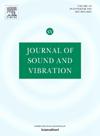Dynamic stability and optimization of a delay-affected drill string with an anti-stall tool
IF 4.3
2区 工程技术
Q1 ACOUSTICS
引用次数: 0
Abstract
This study represents an advancement in the analysis of drilling systems with an anti-stall tool (AST), being the first to develop and apply a continuous drill string model inclusive of the AST dynamics and regenerative drilling effects. The regenerative effect, coming from the cutting process at the drill bit, brings in a complex time delay to the system and causes dynamic instability: the stick–slip vibrations. The AST, featuring a helical spline coupling, is shown to suppress hazardous stick–slip oscillations by transforming excessive external loads into internal relative motions. In this article, the dynamic behaviors as well as the time-delay affected stability were comprehensively analyzed based on the proposed drill-string model. Time-domain analysis reveals the dual role effects of the AST: it is shown to mitigate the stick–slip vibrations at high weight-on-bit and high rotational speeds, while potentially exacerbating the dynamics and stability under low rotational speeds. The stress distribution in the drill string is also shown to be balanced by the AST, which can convert high torsional shear stress into lower axial normal stress, reducing the overall von Mises effective stress. Subsequently, the parametric investigations are carried out and demonstrate that the AST’s structural parameters, particularly the lead of the helical spline, have a strong impact on the drilling stability. The optimized value of the lead of the helical spline is identified between 15 mm to 25 mm. Furthermore, the installation position of the AST is crucial, with an optimal distance from the drill bit of 60 to 100 meters being the most conducive to maintaining the drilling stability. Aiming at enhancing drilling efficiency and ensuring safety, this research provides a groundwork for understanding and optimizing an AST from the aspect of dynamics.
求助全文
约1分钟内获得全文
求助全文
来源期刊

Journal of Sound and Vibration
工程技术-工程:机械
CiteScore
9.10
自引率
10.60%
发文量
551
审稿时长
69 days
期刊介绍:
The Journal of Sound and Vibration (JSV) is an independent journal devoted to the prompt publication of original papers, both theoretical and experimental, that provide new information on any aspect of sound or vibration. There is an emphasis on fundamental work that has potential for practical application.
JSV was founded and operates on the premise that the subject of sound and vibration requires a journal that publishes papers of a high technical standard across the various subdisciplines, thus facilitating awareness of techniques and discoveries in one area that may be applicable in others.
 求助内容:
求助内容: 应助结果提醒方式:
应助结果提醒方式:


